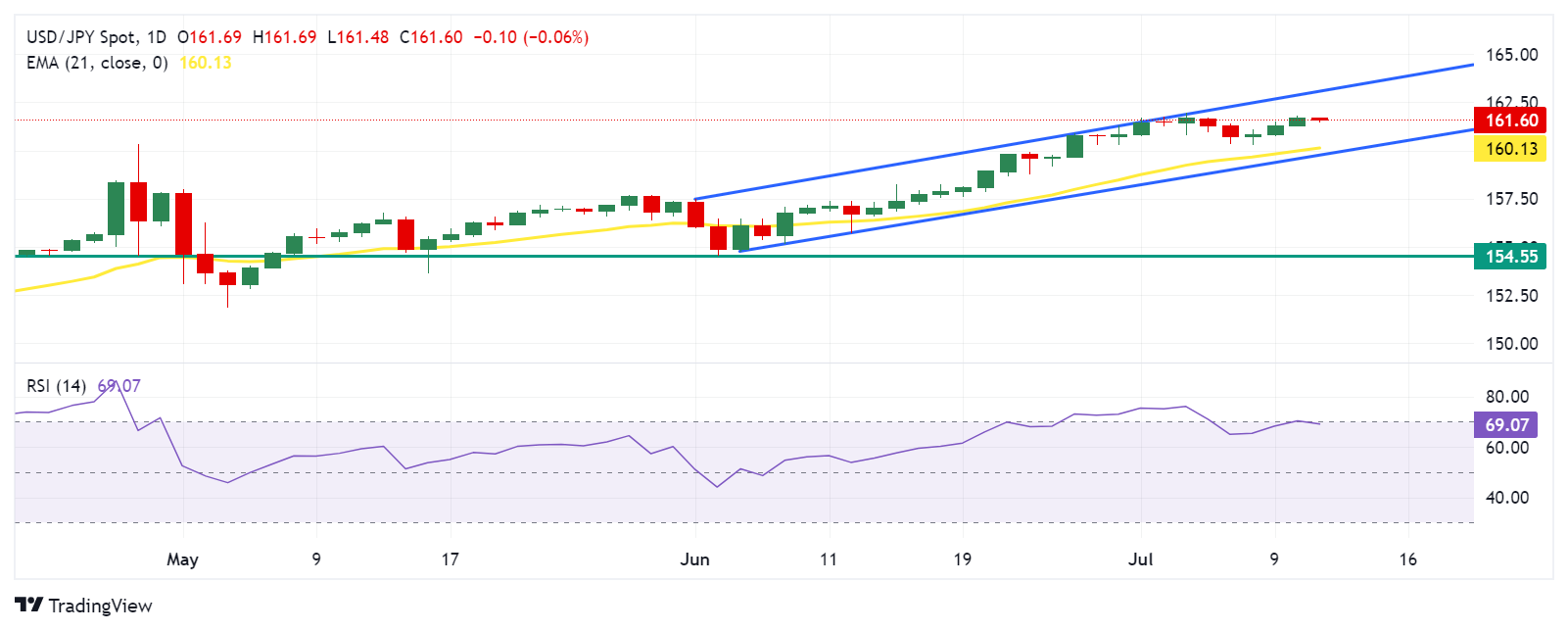Japanese Yen gains ground due to rising expectations of BoJ rate hike, US CPI eyed
- The Japanese Yen strengthens as overseas investors anticipate the BoJ raising rates in July.
- The Japanese government's 10-year JGB yield remains stable at around 1.09%, close to its recent high of 1.10%.
- Fed Chair Powell highlighted the urgent need to monitor the deteriorating labor market.
The Japanese Yen (JPY) halts its three-day losing streak on Thursday. This upside is possibly driven by the rising speculation that the Bank of Japan (BoJ) might raise interest rates at its upcoming July meeting. This development supported the JPY while weakening the USD/JPY pair.
The Japanese government's 10-year JGB yield holds steady at approximately 1.09%, near its peak of 1.1% recorded on July 3. The stability comes amidst selling pressure on Japanese government bonds, reflecting overseas investors' anticipation that the Bank of Japan may raise interest rates in response to a weakening Japanese Yen, as reported by Nikkei Asia.
The US Dollar (USD) weakened, likely impacted by lower US Treasury yields. Fed Chair Jerome Powell highlighted the urgent need to monitor the deteriorating labor market on Wednesday while expressing optimism about the downward trajectory of inflation.
Traders are now eyeing the upcoming US Consumer Price Index (CPI) data for June, scheduled for release on Thursday, for more clarity on the Federal Reserve's (Fed) monetary policy direction.
Daily Digest Market Movers: Japanese Yen improves amid hawkish sentiment surrounding the BoJ
- Peter Boockvar, chief financial officer at US-based Bleakley Financial Group, said that the Yen's weakness will trigger the BoJ to "react sooner rather than later," per Reuters.
- Reuters reported on Wednesday, citing unnamed sources, the Bank of Japan will likely trim this year's economic growth forecast and project inflation will stay around its 2% target in coming years at its meeting this month.
- Fed Chair Jerome Powell stated in his Congressional testimony on Tuesday, "More good data would strengthen our confidence in inflation." Powell emphasized that a "Policy rate cut is not appropriate until the Fed gains greater confidence that inflation is headed sustainably toward 2%." He also noted that "first-quarter data did not support the greater confidence in the inflation path that the Fed needs to cut rates."
- According to a Bloomberg report on Tuesday, the Bank of Japan is conducting three in-person meetings with banks, securities firms, and financial institutions over the next few days. The purpose of these meetings is to assess a feasible pace for scaling back its purchases of Japanese Government Bonds.
- On Tuesday, Japan's Finance Minister Shunichi Suzuki underscored the significance of maintaining fiscal discipline to bolster confidence in long-term fiscal health. Suzuki also mentioned monitoring closely the discussions at the BoJ meeting concerning the bond market, as reported by Reuters.
- The Japanese Yen may struggle due to overseas asset purchases by Japanese individuals through the newly revamped tax-free investment scheme, the Nippon Individual Savings Account (NISA) program. According to Nikkei Asia, the scale of these purchases is expected to exceed the country's trade deficit during the first half of this year.
- Japan’s Ministry of Finance reported on Monday that Japanese investment trust management companies and asset management firms bought ¥6.16 trillion ($38 billion) more in offshore equities and investment fund shares than they sold during the first six months of the year.
Technical Analysis: USD/JPY hovers around 161.50
USD/JPY trades around 161.60 on Thursday, maintaining an upward trajectory within an ascending channel pattern, indicating a bullish bias according to daily chart analysis. Supporting this outlook, the 14-day Relative Strength Index (RSI) sits just below the 70 level, suggesting potential overbought conditions. A breach above this level could signal a need for caution and a possible correction.
The USD/JPY pair may aim for psychological resistance near 163.00, located at the upper boundary of the ascending channel. A successful breakout above this level could reinforce bullish sentiment, potentially pushing the pair toward significant resistance around 163.50.
Conversely, initial support is expected around the 21-day Exponential Moving Average (EMA) at 160.13. A drop below this level might trigger selling pressure, testing the lower boundary of the ascending channel near the psychological level of 160.00. A further decline below this channel support could see the pair revisiting June's low around 154.55.
USD/JPY: Daily Chart

Japanese Yen PRICE Today
The table below shows the percentage change of Japanese Yen (JPY) against listed major currencies today. Japanese Yen was the strongest against the US Dollar.
| USD | EUR | GBP | JPY | CAD | AUD | NZD | CHF | |
|---|---|---|---|---|---|---|---|---|
| USD | -0.08% | -0.11% | -0.08% | -0.04% | -0.23% | -0.23% | -0.10% | |
| EUR | 0.08% | -0.02% | 0.00% | 0.08% | -0.14% | -0.15% | -0.01% | |
| GBP | 0.11% | 0.02% | 0.04% | 0.08% | -0.12% | -0.13% | 0.03% | |
| JPY | 0.08% | 0.00% | -0.04% | 0.03% | -0.16% | -0.21% | -0.02% | |
| CAD | 0.04% | -0.08% | -0.08% | -0.03% | -0.22% | -0.22% | -0.06% | |
| AUD | 0.23% | 0.14% | 0.12% | 0.16% | 0.22% | -0.02% | 0.14% | |
| NZD | 0.23% | 0.15% | 0.13% | 0.21% | 0.22% | 0.02% | 0.16% | |
| CHF | 0.10% | 0.01% | -0.03% | 0.02% | 0.06% | -0.14% | -0.16% |
The heat map shows percentage changes of major currencies against each other. The base currency is picked from the left column, while the quote currency is picked from the top row. For example, if you pick the Japanese Yen from the left column and move along the horizontal line to the US Dollar, the percentage change displayed in the box will represent JPY (base)/USD (quote).
Bank of Japan FAQs
The Bank of Japan (BoJ) is the Japanese central bank, which sets monetary policy in the country. Its mandate is to issue banknotes and carry out currency and monetary control to ensure price stability, which means an inflation target of around 2%.
The Bank of Japan has embarked in an ultra-loose monetary policy since 2013 in order to stimulate the economy and fuel inflation amid a low-inflationary environment. The bank’s policy is based on Quantitative and Qualitative Easing (QQE), or printing notes to buy assets such as government or corporate bonds to provide liquidity. In 2016, the bank doubled down on its strategy and further loosened policy by first introducing negative interest rates and then directly controlling the yield of its 10-year government bonds.
The Bank’s massive stimulus has caused the Yen to depreciate against its main currency peers. This process has exacerbated more recently due to an increasing policy divergence between the Bank of Japan and other main central banks, which have opted to increase interest rates sharply to fight decades-high levels of inflation. The BoJ’s policy of holding down rates has led to a widening differential with other currencies, dragging down the value of the Yen.
A weaker Yen and the spike in global energy prices have led to an increase in Japanese inflation, which has exceeded the BoJ’s 2% target. Still, the Bank judges that the sustainable and stable achievement of the 2% target has not yet come in sight, so any sudden change in the current policy looks unlikely.




